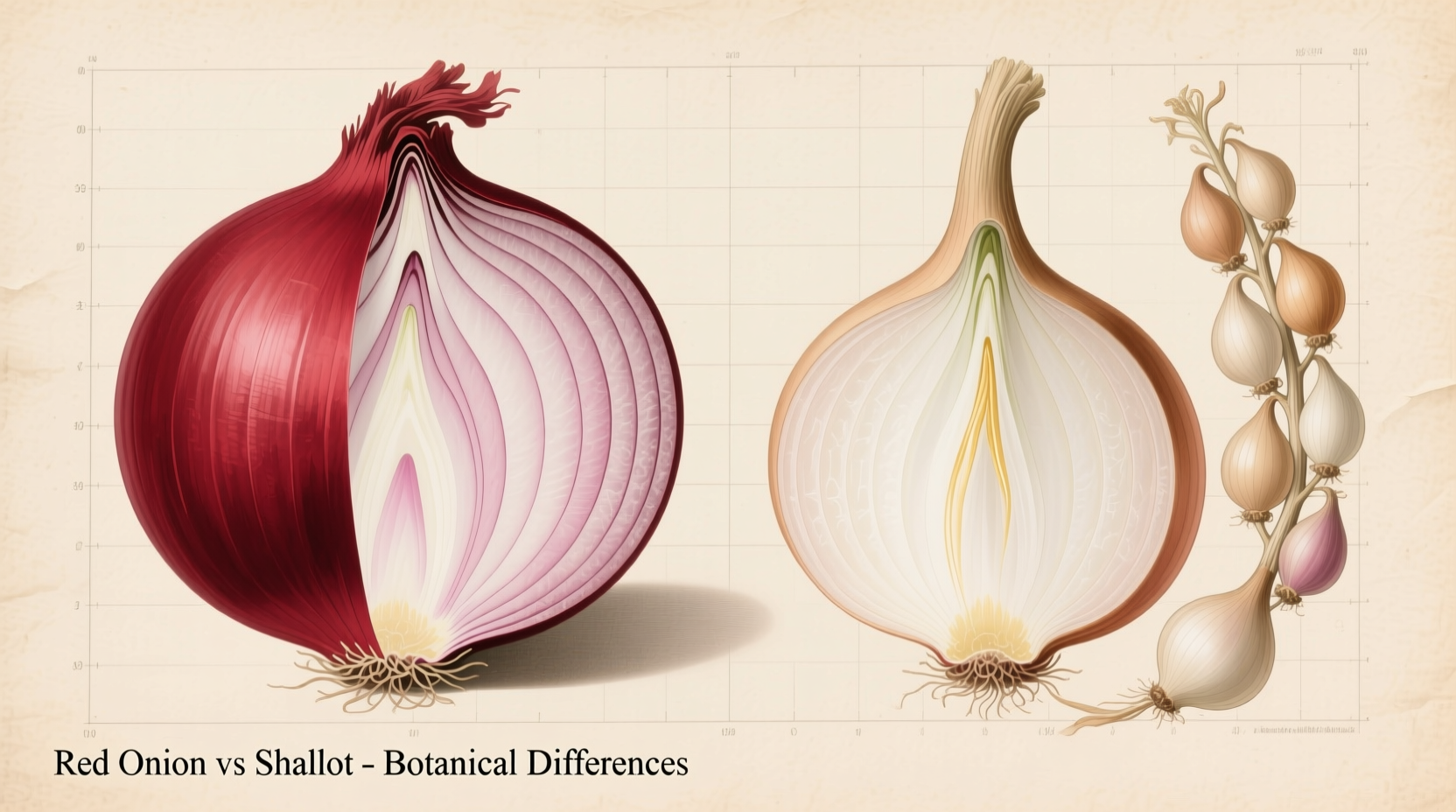Red onions offer a bold, sharp flavor with vibrant purple layers ideal for raw applications like salads and salsas, while shallots provide a delicate, sweet-onion-garlic fusion perfect for sauces, dressings, and fines herbs. Choose red onions when you want color and bite; select shallots for subtle complexity in cooked dishes.
Spot the Difference at First Glance
Before your knife even touches these alliums, visual identification matters. Red onions resemble their yellow cousins but with distinctive deep purple skin and flesh. They typically weigh 4-8 ounces with multiple concentric rings. Shallots, however, grow in clusters like garlic, featuring coppery-brown skin and elongated teardrop shapes. A single shallot bulb usually contains 2-3 individual cloves separated by thin membranes.
| Characteristic | Red Onion | Shallot |
|---|---|---|
| Appearance | Spherical, purple skin and flesh | Clustered cloves, copper-brown skin |
| Flavor Profile | Sharp, pungent, mildly sweet | Delicate, sweet with garlic notes |
| Best Raw Applications | Salsas, salads, burgers | Vinaigrettes, tartare, ceviche |
| Best Cooked Applications | Caramelizing, roasting, grilling | Sauces, reductions, delicate sautés |
Flavor Chemistry: Why They Taste Different
The flavor distinction stems from their unique sulfur compounds. Red onions contain higher concentrations of pyruvic acid, creating that characteristic sharp bite when raw. When cooked, their anthocyanins (the pigments giving purple color) break down into sweeter compounds. Shallots, according to research from the USDA Agricultural Research Service, contain different organosulfur compounds that create their signature sweet-garlic complexity without overwhelming pungency.

Cooking Applications: When to Choose Which
Professional chefs consistently reach for shallots when building flavor foundations. Their delicate profile dissolves beautifully into sauces without dominating other ingredients. Try shallots in béarnaise sauce, French vinaigrettes, or delicate seafood preparations where red onion would overpower. Red onions shine when you want both flavor and visual appeal—thinly sliced on tacos, pickled for banh mi, or roasted alongside root vegetables.
Substitution Guide: Making the Swap Work
Running out of shallots? Use this practical conversion guide:
- 1 shallot ≈ ½ small red onion (but expect more bite)
- For raw applications: Soak chopped red onion in ice water for 10 minutes to mellow sharpness
- For cooked dishes: Add red onion later in cooking process to prevent bitterness
Remember that red onions contain more water than shallots, so reduce liquid slightly when substituting in sauces.
Storage Secrets for Maximum Freshness
Both varieties require proper storage but have different shelf lives. Red onions keep 2-3 months in a cool, dark pantry with good air circulation. Shallots last longer—up to 4 months—but must be stored separately from potatoes which emit ethylene gas that causes sprouting. Never refrigerate whole bulbs as moisture accelerates spoilage, though cut onions should be sealed in airtight containers for 7-10 days.
Nutritional Comparison: Health Benefits
While both belong to the Allium family with similar nutritional profiles, subtle differences exist. According to USDA FoodData Central, shallots contain slightly higher concentrations of flavonoids and allicin compounds per serving. Red onions provide more anthocyanins, the antioxidants responsible for their purple hue. Both offer significant vitamin C, chromium, and quercetin, but shallots edge out red onions in manganese content by about 20%.
Cost Analysis: Budget-Friendly Cooking
Shallots typically cost 2-3 times more than red onions per pound. For budget-conscious cooking, reserve shallots for dishes where their unique flavor shines, like reductions and delicate sauces. Use red onions for applications where color and stronger onion flavor are assets. When shallots are prohibitively expensive, consider using sweet onions like Vidalias as a middle-ground alternative.
Professional Chef Tips for Perfect Results
Seasoned chefs employ specific techniques to maximize each allium's potential:
- For red onions: Slice against the grain to minimize tears and enhance sweetness
- For shallots: Separate cloves before peeling—drop in boiling water for 30 seconds to remove skins effortlessly
- Flavor enhancement: Dry-toast shallot slices before adding to dishes for deeper complexity
- Color preservation: Add vinegar when cooking red onions to maintain vibrant purple hue
Global Culinary Traditions
Culinary traditions worldwide showcase these alliums differently. French cuisine relies heavily on shallots for classic sauces and vinaigrettes, while Mexican cooking features red onions prominently in salsas and street food. In Southeast Asia, shallots form the flavor base for many curries, whereas Mediterranean dishes often use red onions raw in salads and grilled preparations. Understanding these cultural contexts helps recreate authentic flavors in your kitchen.











 浙公网安备
33010002000092号
浙公网安备
33010002000092号 浙B2-20120091-4
浙B2-20120091-4